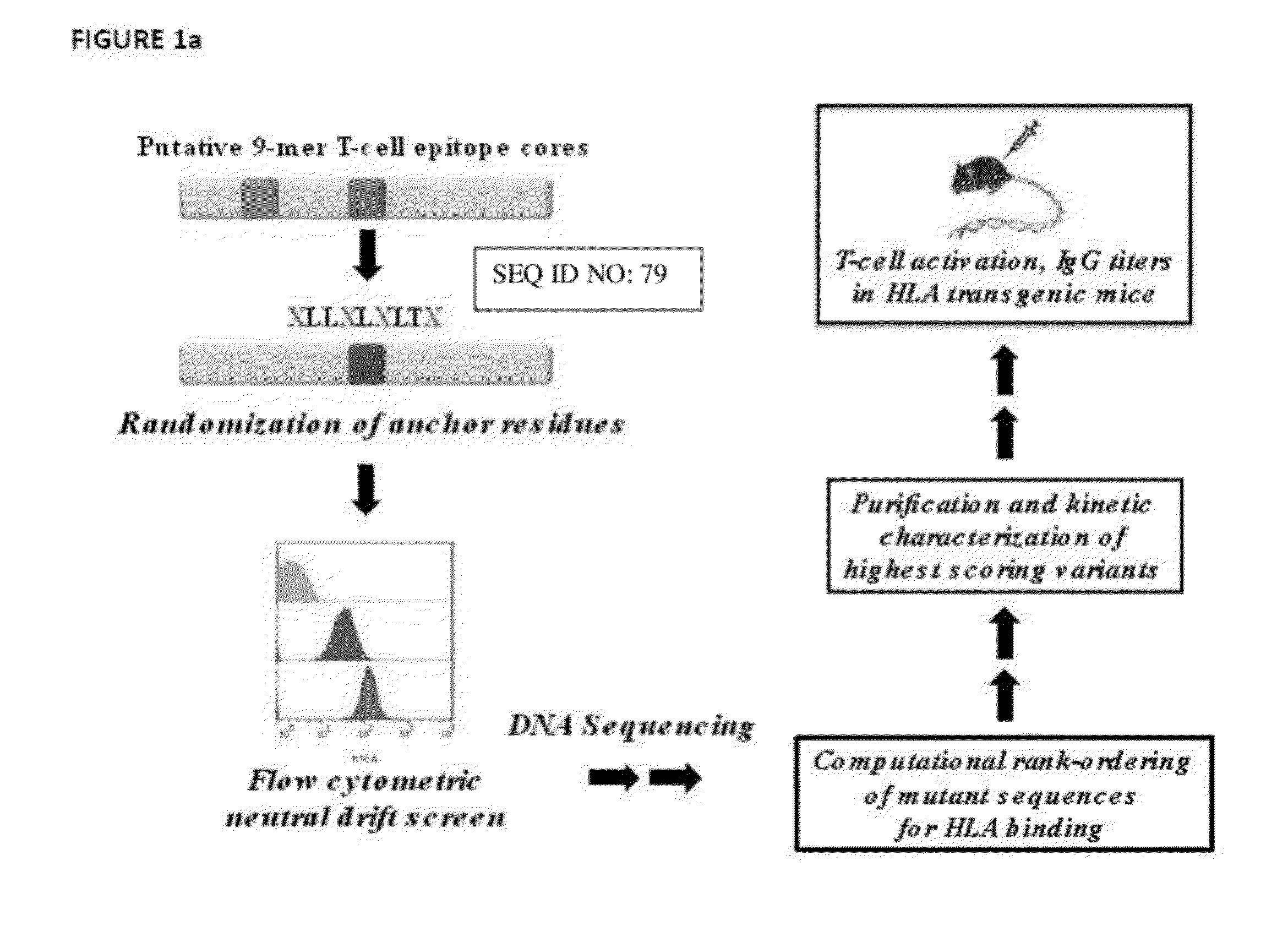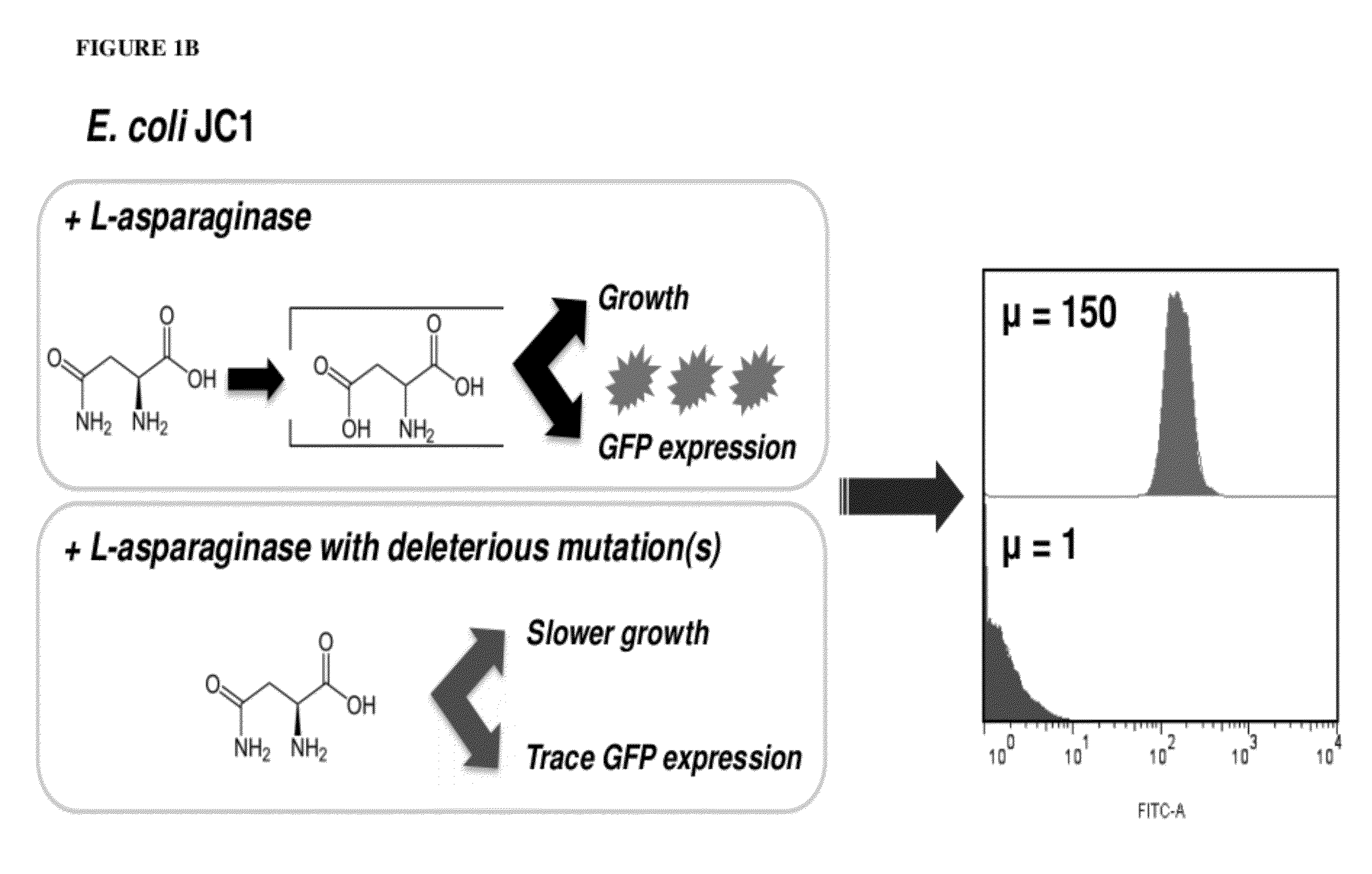Compositions and method for deimmunization of proteins
a protein and protein technology, applied in the field of deimmunization of mutant proteins, can solve the problems of reducing the efficacy of treatment, reducing the effect of immunogenicity, and reducing the effect of treatment discontinuation, so as to reduce the immunogenicity, the effect of increasing the number o
- Summary
- Abstract
- Description
- Claims
- Application Information
AI Technical Summary
Benefits of technology
Problems solved by technology
Method used
Image
Examples
example 1
Materials & Methods
FACS Screening:
[0170]M9 medium supplemented with 0.4% glucose, 3.5 μg / mL thiamine, 1 mM MgSO4, 0.1 mM CaCl2, 160 μg / mL of the amino acids L-Asp and L-Tyr, 80 μg / mL of the 18 remaining amino acids, 30 μg / mL kanamycin, and 200 μg / mL ampicillin was inoculated with a frozen aliquot of E. coli JC1 transformed with pQE80L-GFP (11.3.3) (53) and either a library or a single mutant. Cultures were grown at 37° C. to an A600=0.9-1.1, harvested by centrifugation (6000×g, 4 C, 6 min), and washed twice with cold 0.9% NaCl. The cell pellets were resuspended in supplemented M9 medium containing 19 amino acids (no L-Asp, Tyr at 160 μg / mL, remaining amino acids at 80 μg / mL). GFP expression was induced following the media shift by addition of isopropyl-1-thio-β-D-galactopyranoside (IPTG) to a final concentration of 1 mM. After 1 hr induction at 37° C., the cells were harvested by centrifugation (6000×g, 4° C., 6 min), washed twice with PBS, and resuspended in PBS to a final A600˜0.0...
example 2
Development and Validation of Screen
[0189]To develop a screen for EcAII, the inventors first constructed E. coli JC1 [MC1061 ΔaspCΔtyrBΔansAΔansBΔiaaA] in which the genes required for L-Asp biosynthesis (aspC, tyrB) and the three genes required for endogenous L-asparaginase enzymes were deleted. JC1 cells expressing a low level of recombinant EcAII formed normal size colonies when plated on minimal media plates with 19 amino acids (no L-Asp). In contrast, cells without plasmid or expressing the recombinant, inactive, EcAII-T12A point mutant formed pinpoint colonies, presumably because spontaneous hydrolysis of L-Asn provides a basal level of L-Asp for growth. The formation of pinpoint colonies by null mutants and the cross-feeding of L-Asp generated by low activity clones frustrated efforts to select neutral mutants on plates with selective media; in multiple attempts, similar size colonies formed by plating mutagenized enzyme were later found to encode enzymes with dramatically dif...
example 3
Computational Identification of Putative EcAII T-Cell Epitopes
[0193]Putative EcAII T-cell epitopes were identified using the Immune Epitope Database (IEDB) consensus method (16). The protein sequence was parsed into overlapping 15mer peptide fragments (staggered by one residue) and within each fragment, 9-mer core regions were scored for predicted binding first to HLA-DRB1*0401, which shows strong association with childhood ALL in males (44), and then to an additional seven HLA-DR alleles that collectively cover nearly 95% of the human population (45). Three 9-mer core regions scored with a consensus percentile rank (CPR) within the lowest 10% of the parsed peptide fragments for binding to DRB1*0401 (CPR115RPSTSMSA, I216VYNYANAS, and V304LLQLALTQ (designated M115, I216, and V304 where these three residues correspond to the respective P1 positions).
PUM
 Login to View More
Login to View More Abstract
Description
Claims
Application Information
 Login to View More
Login to View More - R&D
- Intellectual Property
- Life Sciences
- Materials
- Tech Scout
- Unparalleled Data Quality
- Higher Quality Content
- 60% Fewer Hallucinations
Browse by: Latest US Patents, China's latest patents, Technical Efficacy Thesaurus, Application Domain, Technology Topic, Popular Technical Reports.
© 2025 PatSnap. All rights reserved.Legal|Privacy policy|Modern Slavery Act Transparency Statement|Sitemap|About US| Contact US: help@patsnap.com



